Weeknight Ground Beef & Veggie Skillet Hash with Spicy Peanut Sauce
Plus why we all need lupin flakes and lupin flowers in our lives
Colorful chefs - happy Thursday 💚
This is where we cook easy, delicious, saucy, colorful meals made from whole, unprocessed foods, and we make it fun, easy, and learn important stuff about metabolic health and home cooking while doing it.
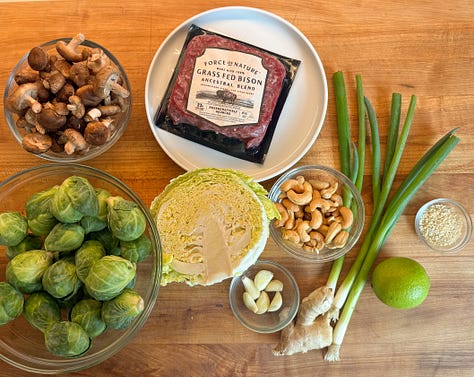
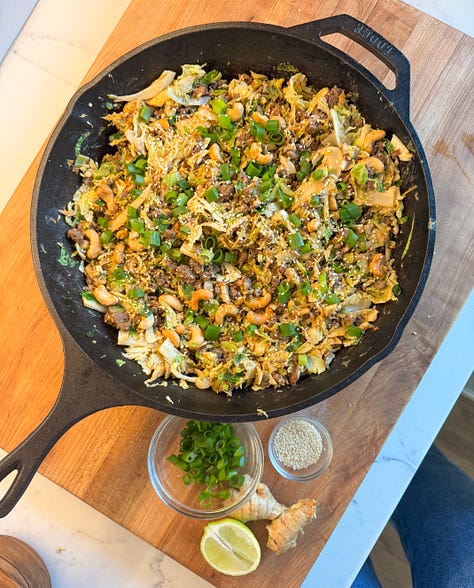

🥘 Weeknight ground beef & veggie skillet hash with spicy-ish peanut sauce
😋 The lupin flakes you didn’t realize your pantry needed
🤌🏻 A reminder that herbs are one of your greatest zhuzh’ing tools
🤓 The home cooking through science fun fact of the week
Let’s get into it 👇🏼
Weeknight ground beef & veggie skillet hash with spicy-ish peanut sauce
This recipe was honestly an accident and the result of needing to whip up a flavorful nutrient dense meal in 20 minutes, but it was so dang good it got promoted into an official Color Club recipe. It works with any ground meat and pairs well with various vegetables, but the spicy-ish (up to you on how hot!) peanut sauce is what brings it all together.
The lupin flakes you didn’t realize your pantry needed
My friends at Chef’s Kiss launched lupin flakes and I believe this is a MUST-HAVE pantry staple. They are perfect to have on hand as a breadcrumb replacement for meatballs, meatloaf, chicken tenders (my take on the Erewhon turmeric tendies coming soon), crab cakes, stuffed mushrooms, mac and cheese, gazpacho — the list goes on! They are high fiber and high protein, and because everyone loves a comparison chart, see below 👇🏼

The ingredients are 100% Australian Ground Lupins, nothing else. They are grown in Australia without the use of any pesticides and Chef’s Kiss tests them to ensure no heavy metals. You can use code SONJA for 20% off.
Fun fact: Lupins are actually gorgeous purple flowers that I mistook for lavender when in New Zealand. They were EVERYWHERE. Lupins don’t require additional irrigation and they even support surrounding crops nutritionally when farmed. Such remarkable little flowers!
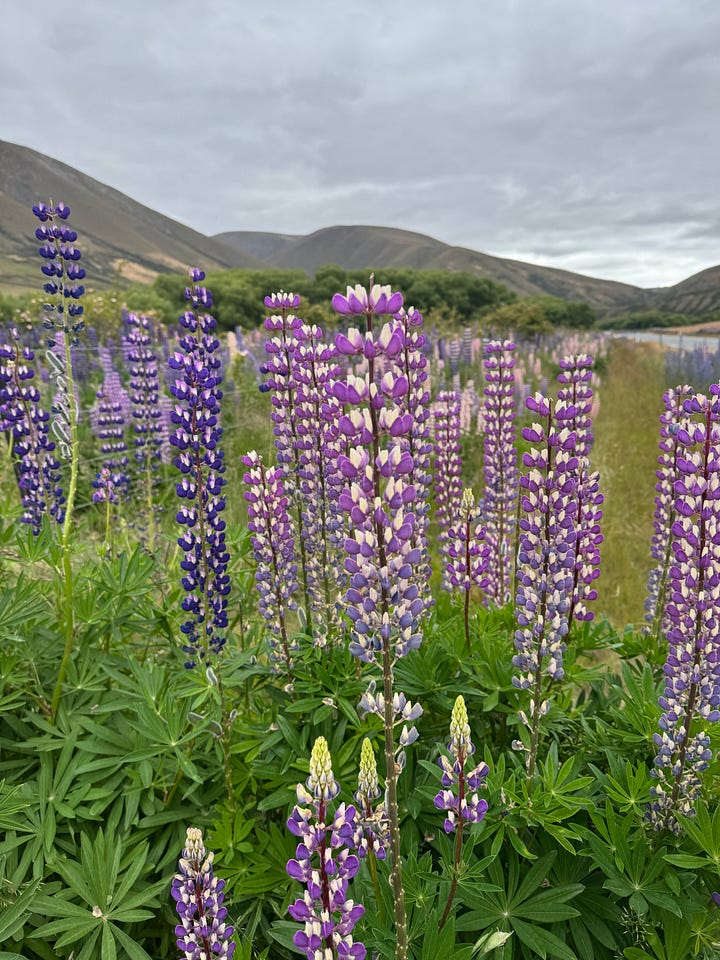
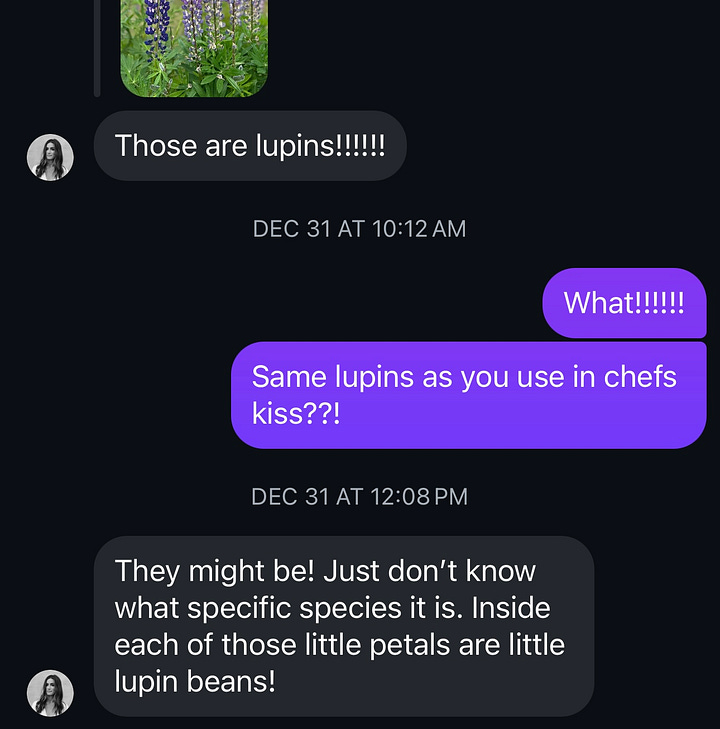
A reminder that herbs are one of your greatest zhuzh’ing tools
I finally replanted my herb garden after they were all covered in ash post-LA fires, and I didn't realize how much I missed having herbs on hand until I went without them for the last month.
I will buy herbs at the store in a pinch, but I try not to because:
You pay a huge premium for a tiny bunch of herbs
They go bad quickly and I often find myself throwing half away and then feeling guilty about it
Tip: If you must buy herbs, extend their life by trimming the stems and placing them in a glass of water in the fridge (like flowers) or wash them and put them in a glass tupperware on top of a paper towel.
They are not as flavorful because they are often harvested prematurely to survive transport so they are not at their peak flavor when you purchase them
They might travel anywhere from 500-1500 miles depending on where you live, and in the winter they can travel even further because they need to be imported (which is why it’s great to have dried herbs to use in off-seasons!)
They usually come in plastic. No further explanation needed.
Luckily, herbs are so easy to grow whether you have a huge yard or a small patio!!
Why herbs are good for your health: Herbs are a micronutrient that are high in polyphenols - which are tiny plant chemicals that act as antioxidants and feed our microbiomes. A quote from Good Energy by my good friend Dr. Casey Means explains why we should value those mighty little polyphenols.
While we typically think of fiber as being the food substance fermented by the microbiome, recent evidence suggests that the microbial transformation of polyphenols through fermentation can yield metabolites that can enter the body and promote a range of positive biological effects, including acting as protective neurotransmitters in the brain and directly reducing the growth of cancer cells and including stopping cancer cells from taking up glucose for energy. More than eight thousand known polyphenols exist in plants, and they offer a Swiss Army knife of benefits for cells. Foods with the highest polyphenol count are dried spices and herbs, followed by cocoa, dark berries, seeds and nuts, many vegetables, coffee, and tea.
Herbs also contain compounds that reduce inflammation (e.g., turmeric, rosemary, thyme, tarragon), support digestion (e.g., mint, fennel), and have antimicrobial and antibacterial properties (e.g., oregano, thyme). Herbs have been an integral part of the human diet for thousands of years and are deeply rooted in ancestral traditions. We all need to un-learn a lot of what’s been taught to us about food in the last 100+ years and go back to relying on some of that ancestral wisdom.
Why they are good for zhuzh’ing: So, now that I’ve made the case for their health benefits, let’s get down to the most important point — FLAVOR. Herbs are one of my favorite things for zhuzh’ing up any meal (one of the core principles of Cooking in Color - a little zhuzh). You can incorporate herbs a MILLION ways into your meals:
Chop and sprinkle on top of roasted veggies
Mix into a sauce (my fave — greek yogurt, tahini, lemon, salt, whatever herbs on hand - dill, parsley, cilantro etc.)
Add to a salad
Mix into a dressing or marinade
Add into any soup or stew
Mix with eggs (chives + soft scrambled eggs 🤌🏼)
Make herbal teas
HERB BUTTER — mix softened butter with chopped herbs
Many recipes I’ve found don’t call for herbs and it’s such a shame because herbs really enhance almost every. single. recipe.
For example, I made roasted sweet potato and carrot fries a few nights ago and they needed a little something. I chopped up some parsley and sprinkled it on top, and it instantly made the dish 100x better.
So, find your local garden store — buy some pots or a small planter, and build yourself an herb garden for spring! Here’s my mini planter.
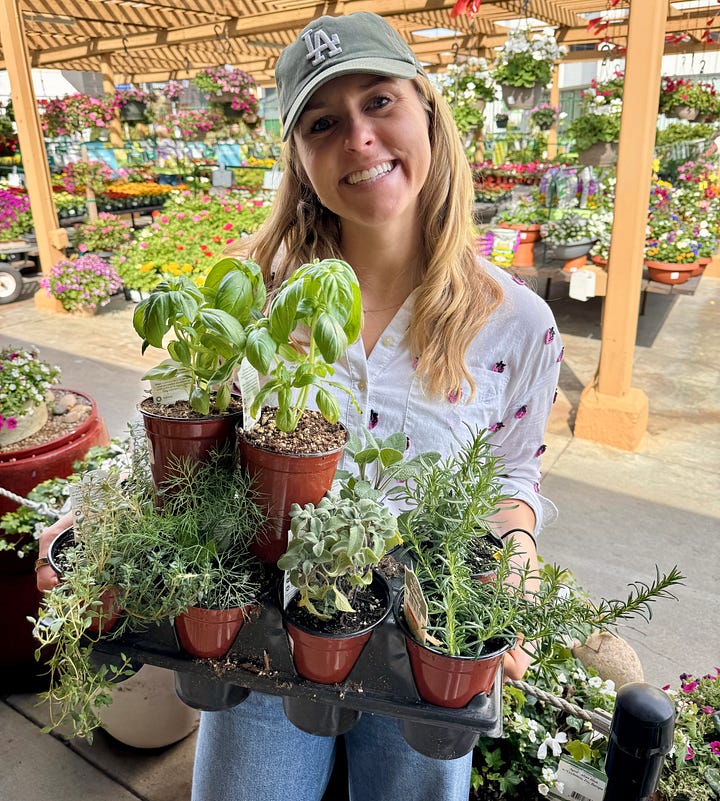

The home cooking through science fun fact of the week
This week’s tip from my current evening read — The Food Lab by J. Kenji Lopez-Alt is about properly pre-heating your pans. If you are like me, you probably never really understood why people said it was important to pre-heat pans before…so sometimes you skipped it and just dumped the oil on the pan and turned the heat on at the same time, or threw in the garlic and then turned the heat on.
Here’s why pre-heating matters:
Ensures even cooking – If you start cooking on a cold or lukewarm pan, the food may cook unevenly because different areas of the pan heat up at different rates.
Develops a better sear & crust – The Maillard reaction (which creates rich, complex flavors, perhaps I’ll do a deep dive into that one next week) only occurs at high temperatures. If the pan is too cool, food releases water before browning, leading to steaming instead of searing.
Reduces oil absorption – Inadequate heat causes food to soak up oil instead of frying in it, leading to a greasy texture!
Prevents sticking – This is the most important reason in my mind (and for Alex, who does the majority of the dishes). Food is more likely to stick to a pan that is not properly preheated. When the pan is hot enough, proteins begin to cook immediately instead of bonding with the metal surface. 🤯
So here’s what you’ll do when you make dinner tonight:
Choose the right pan:
Your stainless steel, cast iron, and carbon steel pans need proper preheating
Nonstick pans (like your non-toxic Caraway pans!) should not be overheated (aim for medium heat)
Dry the pan first
Heat the pan on its own BEFORE adding oil. This ensures an even heat distribution without the oil burning prematurely.
Use the “water droplet” test (only works in stainless steel & cast iron)
Heat the dry pan on medium-high heat for about 2–3 minutes.
Flick a few drops of water onto the surface:
If the water just sits there and evaporates slowly, the pan is too cold.
If the water sizzles and evaporates quickly, it’s still not quite hot enough.
If the water droplets bead up and dance around, the pan is ready! This is called the Leidenfrost effect, meaning the pan is hot enough to instantly vaporize water at the point of contact, preventing sticking.
Add oil after preheating
Once the pan passes the water test, add your olive oil.
The oil should shimmer and move fluidly, but not smoke excessively. If this is the case, either turn your heat down or use a different oil with a higher smoke point.
Then proceed in making your delicious, colorful, nutrient dense dinner! Or perhaps even the recipe of the week below!
The reason behind this one is simple — we all need a few go-to, flavorful, quick meals that are also nutrient-dense and support our cellular health. This is one of mine, and I hope it quickly becomes one of yours! The spicy-ish peanut sauce makes this so crave-able, and it reheats beautifully for leftovers, so you can look forward to your lunch the next day if you make this for dinner.
I use the Ancestral Ground Beef Blend from Force of Nature, but you can use any ground meat in this recipe and a variety of different vegetables (see ideas in the swaps section in the recipe notes)
You’ll notice in the recipe video I also use Lineage Beef Tallow. I’m currently leading Marketing at Lineage, so I’m obviously a bit biased, but I’ve been loving learning about and cooking more with tallow lately. It’s a great cooking fat due to its high smoke point, and it contains no trans fats because it is a naturally stable, minimally processed animal fat, unlike industrial seed oils that undergo high-heat processing and hydrogenation, which create harmful trans fats.
Tallow is also rich in fat-soluble vitamins like A, D, E, and K, as well as conjugated linoleic acid (CLA). CLA is a naturally occurring omega-6 fat found in grass-fed animal products that has anti-inflammatory, fat-burning, and potential anticancer benefits. Not to be confused with linoleic acid (LA) that is an unstable omega-6 fat found in seed oils and processed food that is prone to oxidation, promotes inflammation, and is linked to metabolic issues when consumed in excess.
All tallow has some combination of CLA and LA, but the Lineage tallow has 25% less linoleic acid (LA) than most tallows on the market (we’ve tested it). This is one of the reasons why Lineage customers notice our tallow has a higher smoke point!
A question I’ve gotten a few times is, “Wait, isn’t tallow bad because it’s a saturated fat?”
First, saturated fats are a natural type of fat found in animal products that provide essential energy and support cellular function.
Second, modern research has shown that they do not inherently contribute to heart disease when consumed as part of a balanced diet. There have been multiple meta-analyses of studies on the relationship between saturated fat and heart disease, and these studies generally found no significant associations (PMID: 31841151, PMID: 36477384,PMID: 32523453). It’s obviously important to differentiate these natural saturated fats from those found in highly processed foods, which often do contain trans fats and other harmful additives.
So, in summary:
Figure out what your go-to, healthy, made-in-20-minutes meals are — hopefully, this one becomes one of them!
Make this your own — swap out the meat, adjust the veggies, and tweak the spice level of the sauce
Don’t be afraid of saturated fats from high-quality animal products like grass-fed beef tallow!
Ground Beef& Veggie Skillet Hash with Spicy Peanut Sauce
RECIPE LINK HERE
If you like my recipes but the price of joining the Color Club is a barrier at the moment, simply respond to this email saying “I’d like to be a Color Club member” and I’ll happily set you up with a free year membership, no questions asked.
Otherwise, the recipe below is part of my Color Club - $5/month or $50/year.
Any metabolic health information, or home chef learnings that I share on my Substack is and will always remain free. However, to avoid ads I’ve decided to charge a small fee for my recipes themselves.
If you make this recipe (or ANY of my recipes!), I’d love nothing more than to hear how it turned out and any feedback you have! Comment below or on the recipe in the Color Club, and if you are on IG, tag me @sonjakmanning.
Lastly, if you heart or re-stack this post, you’ll help me and colorful recipes reach more people! 🙏🏼
Chefs kisses,
Sonja


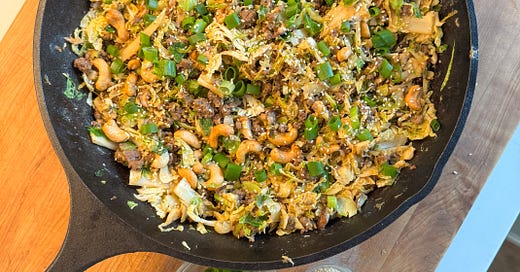




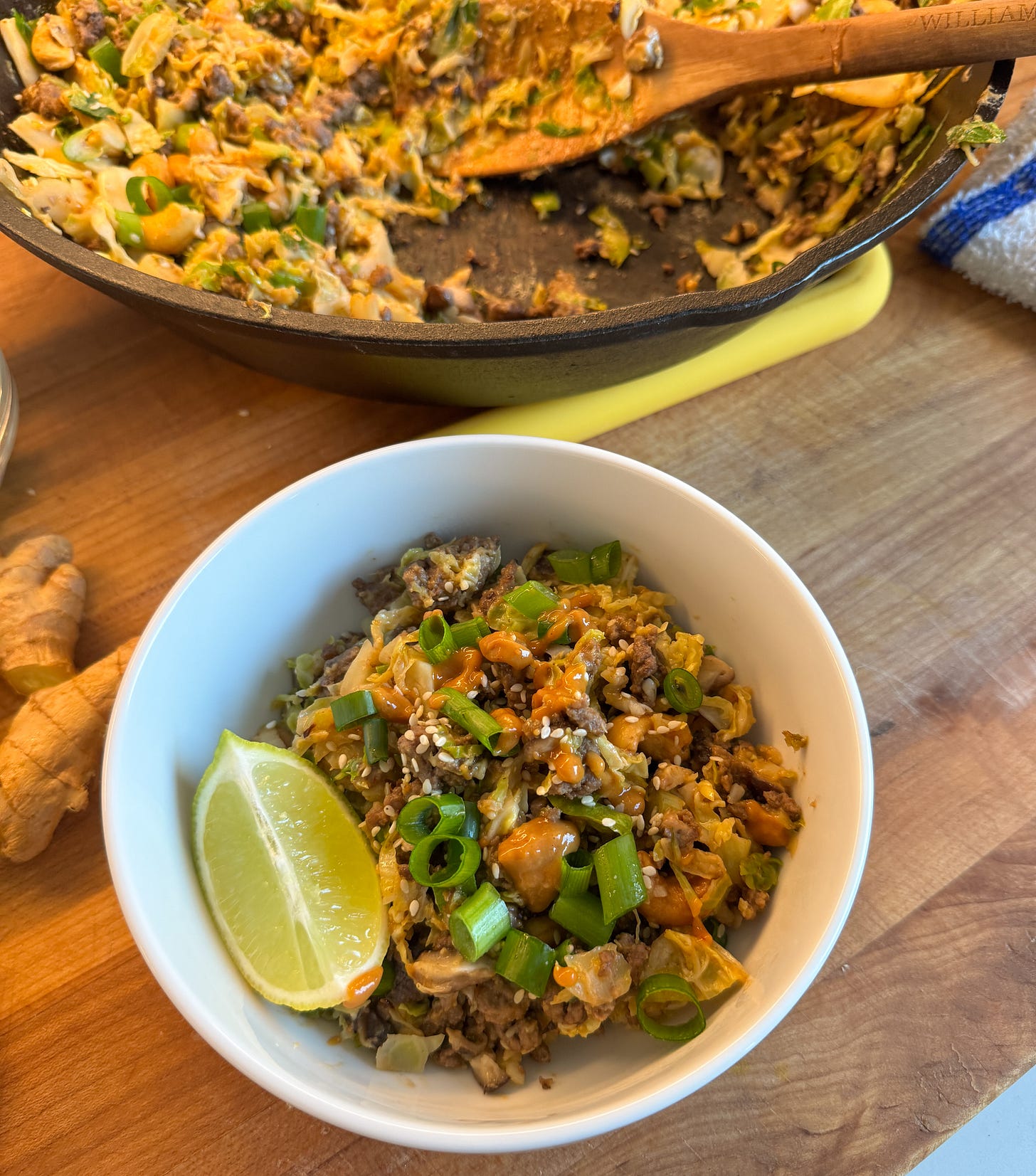

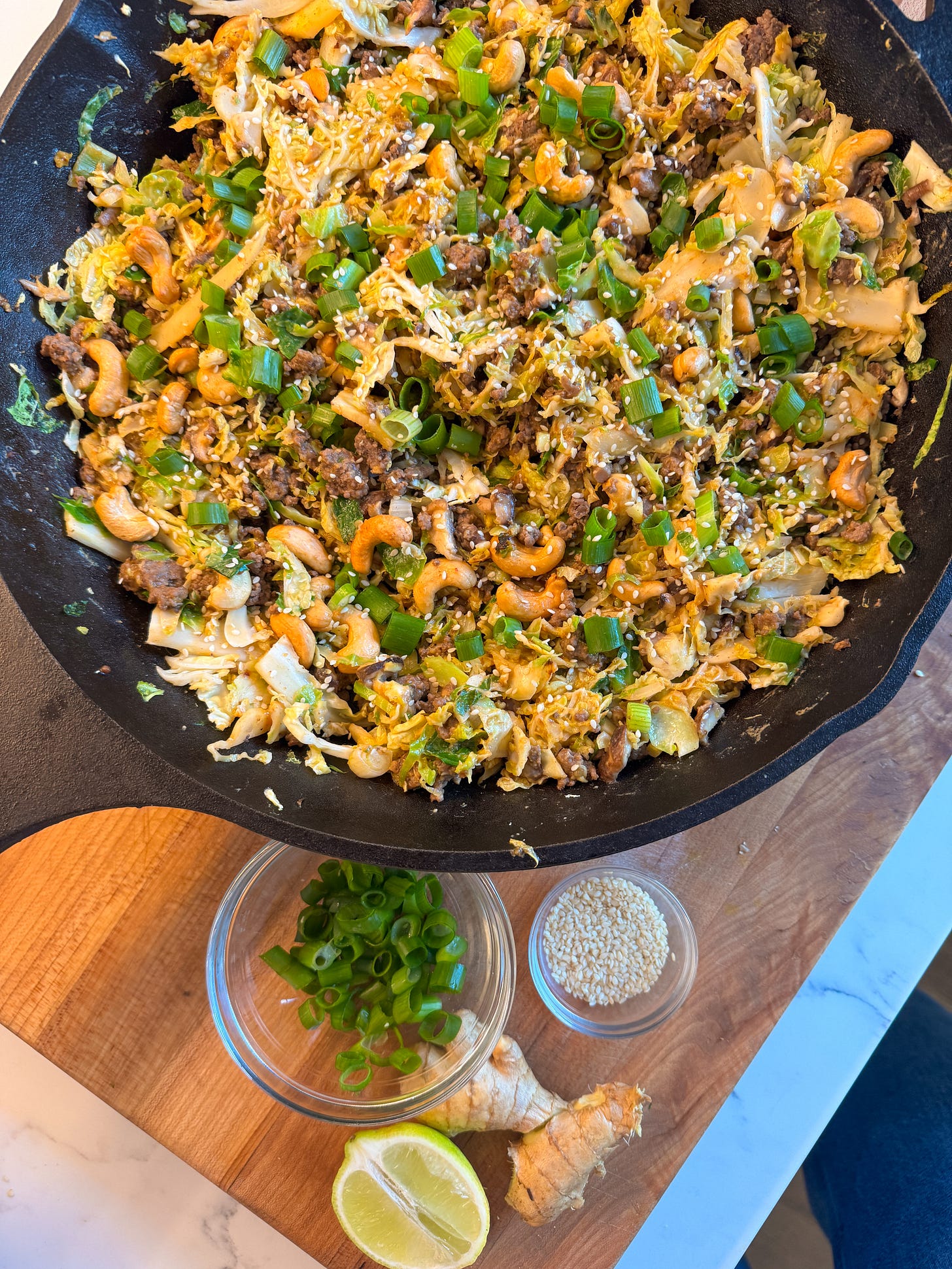
Lineage has amazing products. Their tallow is the best. I add a little bit to my tea in the mornings; it really is delightful (don’t knock it until you try it!) of course it’s amazing to cook with too.
Thanks for the recipe. Excited to try it.
Thank you! This was a wonderful article.